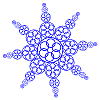Stop and Continue
 | | STOP AND CONTINUE |
"Every message is made of signs" (Ferdinand de Saussure).
"Language consists of a set of signifiers" (Jacques Lacan).
Stop (Halt)
Semantics
Stop or halt the current process, or stop one or more processes.
Syntax
■ // Stop the process in progress.
(■ (p1 ... pn)) // Sequentially stop processes p1 to pn
(■ {p1 ... pn}) // Simultaneously stop processes p1 through pn
Justification
It is the way to stop one or more processes. The stoppage may be permanent or temporary.
If it is permanent it may be because the process has been terminated or because an error condition has occurred.
If it is temporary it is because it could be resumed for different causes, for example:
- If another process would change the stop symbol by its opposite (continue), because it eliminates it or because it replaces it by another expression.
- If the stop is the result of a condition within a generic expression and this condition changes.
Examples
((x*y ≥ n) → ■) // pause by condition
⟨( x÷0 ≥ ■ )⟩ // stop process if division by zero>
⟨( x=2 → y=4 → z=5 → ■ )⟩ // stop at the moment the triple condition is met
(■ p) // stop process p
(■ (p1 p2)) // stop sequentially processes p1 and p2
(■ {p1 p2}) // stop simultaneously the processes p1 and p2
Remarks
- At the end of a program code it is not necessary to include the Stop symbol.
Continue (Resume)
Semantics
Continue or resume the current process or continue or resume one or more processes.
Syntax
▶ // Resume the current process.
(▶ (p1 ... pn)) // Resume sequentially the processes p1 to pn
(▶ {p1 ... pn}) // Simultaneously resume processes p1 through pn
Justification
It is the opposite operation to Stop:
(■' = ▶) (▶' = ■)
Examples
(▶ (p1 p2)) // sequentially resume processes p1 and p2
⟨( ((x*y ≥ n) → (▶ p)) )⟩ // resume p when the condition is met
(p = (x y ■ z u)
((p\3)° = ▶) // change stop symbol to resume symbol
Remarks
- The processes to be resumed must be stopped. If they are not, the operation has no effect.
